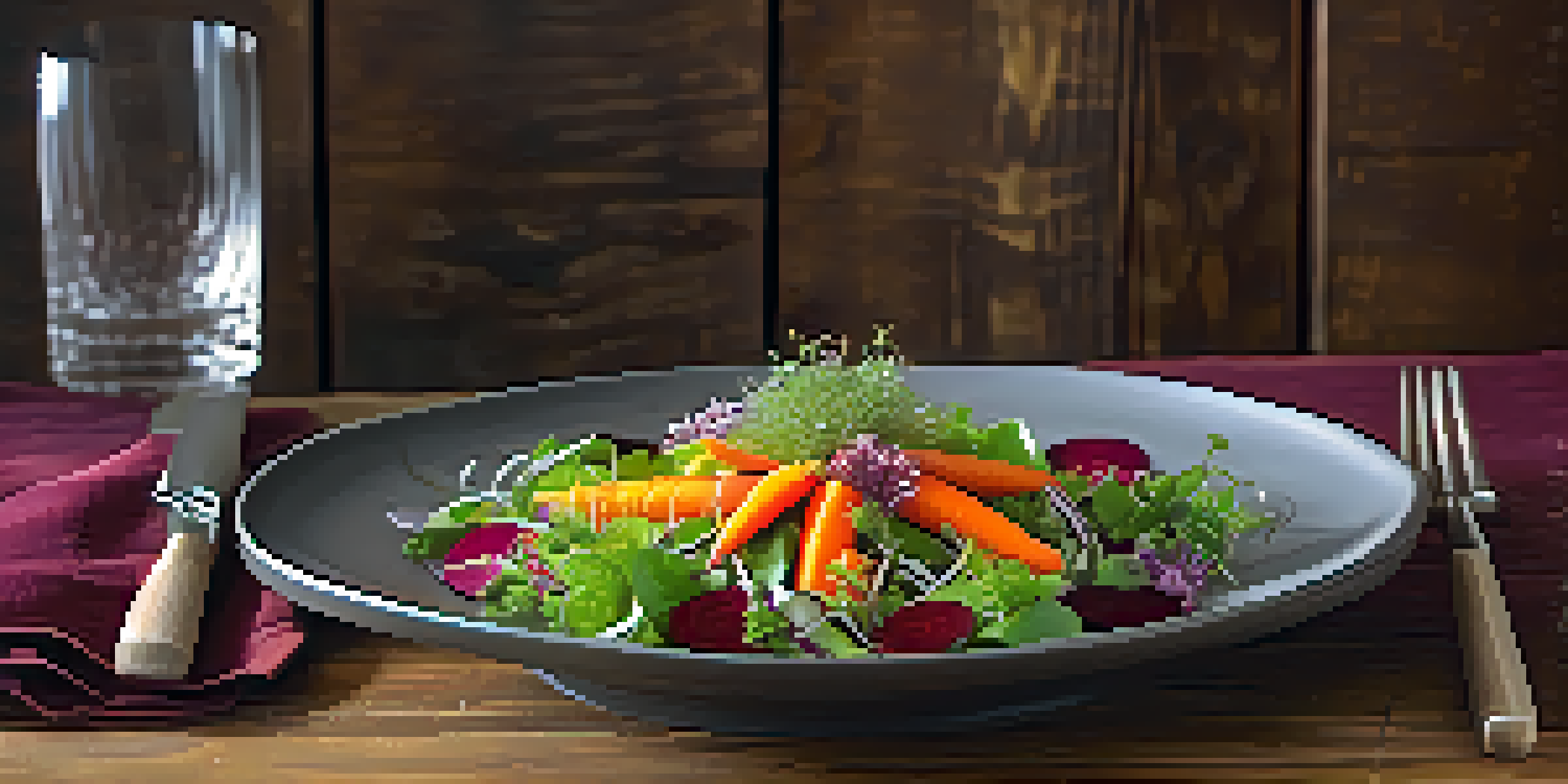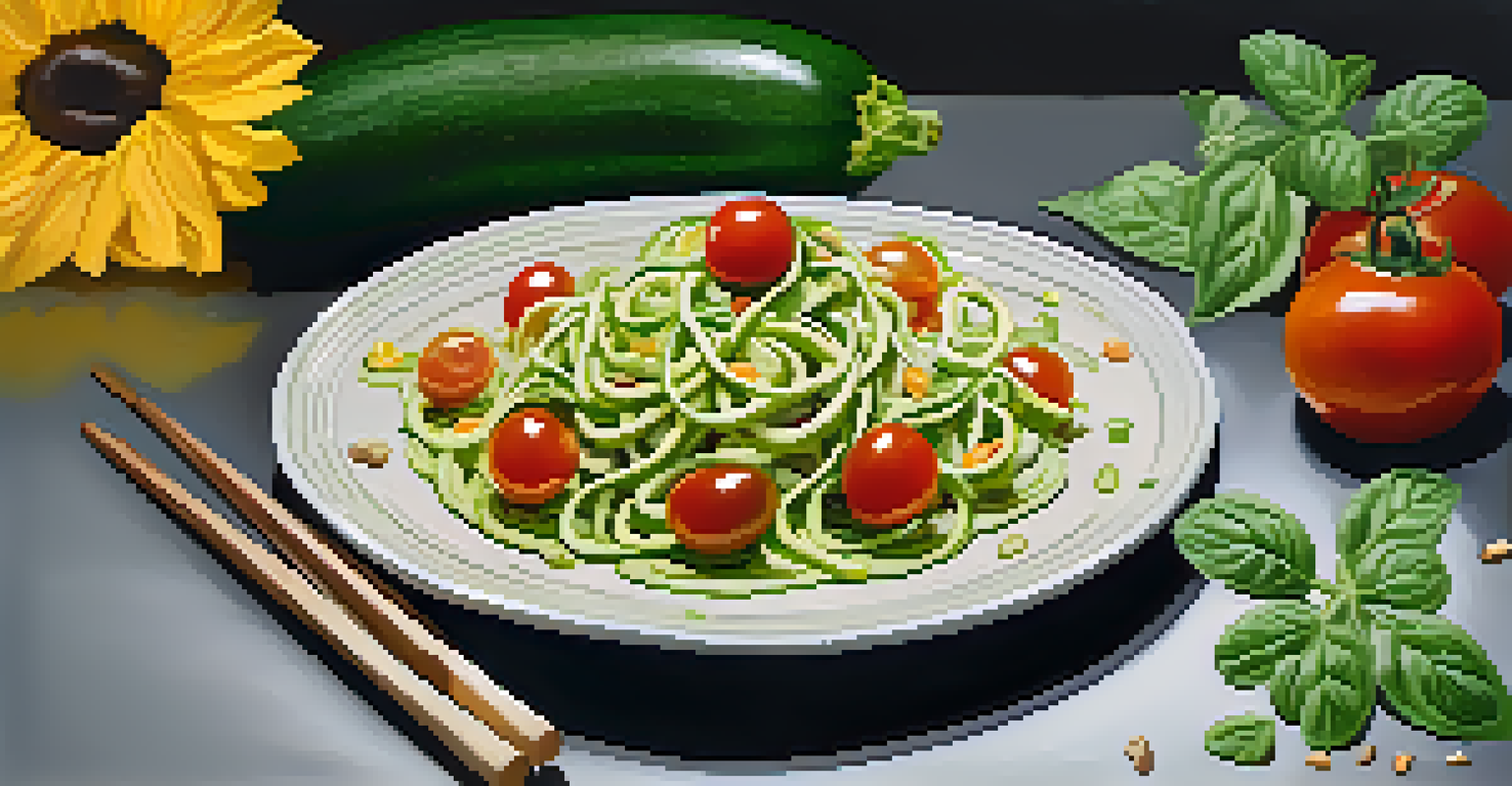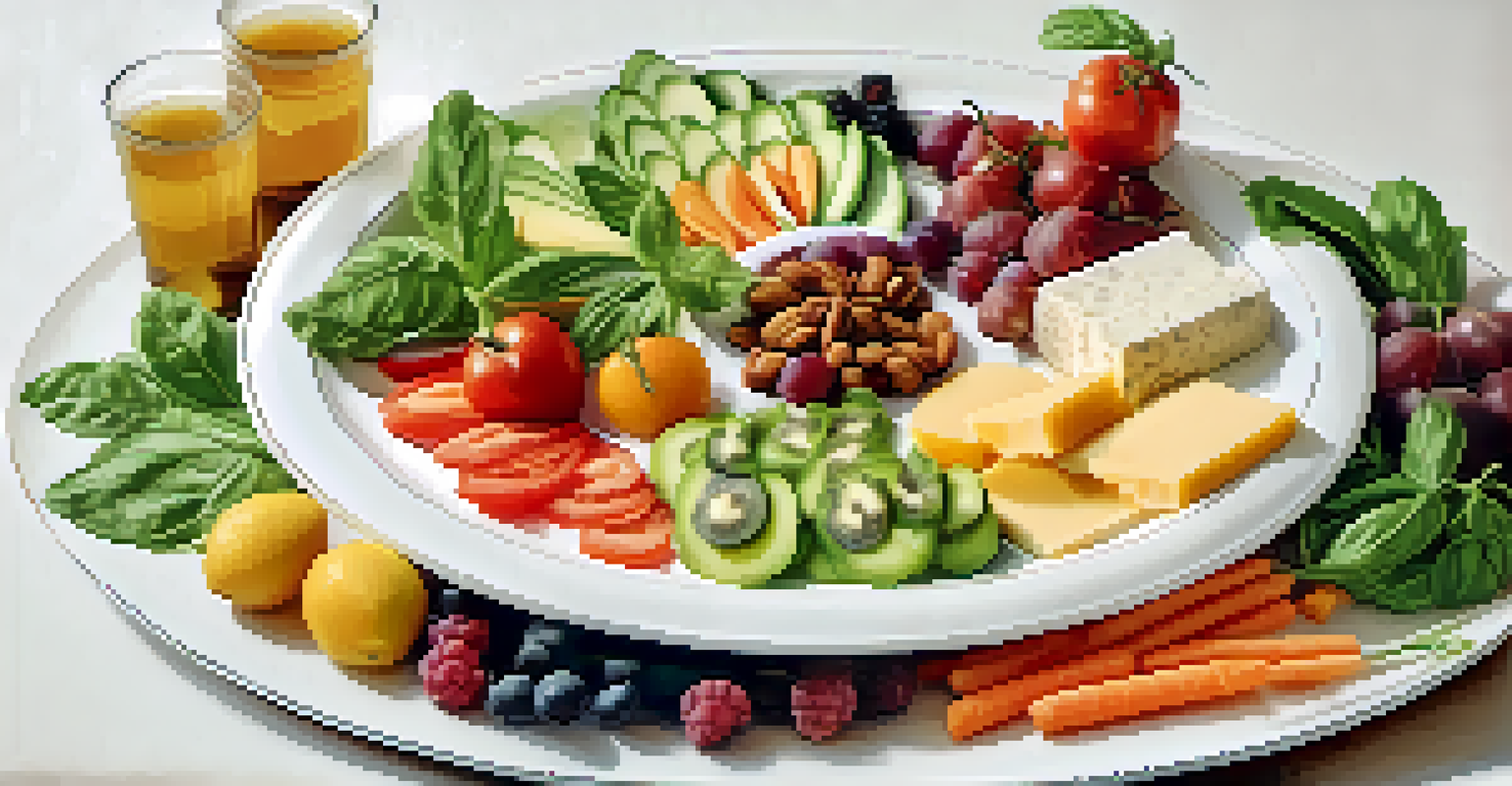The Art of Plating Raw Food in Modern Cuisine

Understanding the Importance of Presentation in Raw Food
Presentation is essential in raw food cuisine, as it transforms simple ingredients into a visual feast. Just like a painter carefully selects colors for their canvas, chefs arrange raw ingredients to evoke emotion and excitement. When a dish looks appealing, it not only whets the appetite but also enhances the overall dining experience.
Food is not just what we eat; it is an experience, and how we present it can enhance the joy of dining.
In modern cuisine, where aesthetics play a significant role, plating is an art form that can elevate a dish from ordinary to extraordinary. Imagine biting into a beautifully arranged salad that looks like a garden on your plate; it can make the flavors more enticing. This focus on visual appeal encourages diners to appreciate not just the taste but also the creativity behind the meal.
Moreover, a well-plated dish can tell a story about its ingredients, origin, and preparation. For instance, using vibrant colors and varied textures can showcase the freshness of the produce, inviting diners to explore the flavors that await them. In the realm of raw food, where the ingredients are often the stars, thoughtful presentation is key.
Color Theory: Creating Visual Harmony on the Plate
Color theory plays a vital role in plating raw food, as it can influence the mood and perception of a dish. Just like in art, combining complementary colors can create a pleasing aesthetic that draws attention. Think of a vibrant beet salad adorned with bright orange carrots and crisp greens; the contrast not only captivates the eye but also hints at the mix of flavors.

When plating, consider the color wheel as your guide. For example, pairing warm colors like red and orange with cool colors such as green and blue can create balance and harmony. This approach allows chefs to highlight the freshness and quality of their ingredients, making raw dishes more appealing and inviting.
Presentation Transforms Dining Experience
Thoughtful presentation of raw food not only enhances visual appeal but also elevates the overall dining experience.
Additionally, using natural colors found in fruits, vegetables, and herbs can elevate the overall presentation. A colorful plate not only looks beautiful but also indicates a variety of nutrients, which is particularly important in raw food cuisine. By embracing color theory, chefs can enhance the visual experience while promoting healthy eating.
Textures: Adding Dimension to Raw Food Presentation
Texture is a crucial element in the art of plating, especially in raw food dishes that may otherwise appear flat. Incorporating a mix of crunchy, creamy, and chewy elements can create a more dynamic experience for the diner. For instance, a raw zucchini noodle salad could be complemented by crunchy sunflower seeds and a silky avocado dressing, adding layers of interest.
The art of plating is the art of creating a story on the plate, inviting everyone to partake in the narrative of flavor and creativity.
When arranging your plate, think about how different textures can interact. A dish that combines smooth purees with crispy toppings creates a delightful contrast that entices the palate. This not only makes the dish more appealing but also adds a playful element to the dining experience.
Furthermore, varying textures can enhance the overall flavor profile of a dish. A raw food platter that includes crispy vegetables, soft fruits, and nut-based cheeses provides a satisfying journey for the taste buds. By thoughtfully incorporating textures, chefs can transform raw ingredients into a memorable culinary experience.
Shapes and Arrangements: Crafting Visual Interest
The shapes and arrangements of food play a significant role in its presentation. Chefs can utilize geometric shapes—like squares, triangles, and circles—to create visually striking compositions. For example, stacking sliced vegetables in a circular pattern can add height and elegance to a dish, making it more visually appealing.
Beyond shapes, the arrangement of food on the plate can guide the diner's eye and create a sense of movement. Placing elements in a diagonal line or in clusters can draw attention to specific components of the dish. This technique not only enhances the visual appeal but also invites exploration of the different flavors.
Color Theory Enhances Visual Appeal
Utilizing color theory in plating can create visual harmony and highlight the freshness of ingredients.
Moreover, using negative space strategically can make the plated dish stand out even more. Leaving empty areas on the plate can highlight the food itself, allowing the vibrant colors and textures to take center stage. Emphasizing shapes and arrangements encourages creativity while crafting an unforgettable dining experience.
Utilizing Garnishes and Accents for Enhanced Appeal
Garnishes and accents are the finishing touches that can elevate a raw food dish from good to great. A sprinkle of microgreens, a drizzle of infused oil, or a dash of edible flowers can add a pop of color and enhance the overall presentation. These small additions not only beautify the plate but can also introduce new flavors or textures.
When selecting garnishes, it's important to choose ingredients that complement the main components of the dish. For example, a raw avocado tart can be accentuated with a few slices of radish or a sprinkle of sesame seeds for added crunch and visual contrast. Thoughtful garnishing can turn a simple dish into a work of art.
However, it’s crucial to strike a balance; too many garnishes can overwhelm the plate and distract from the main ingredients. Less is often more in the world of plating. By using garnishes sparingly and purposefully, chefs can enhance the beauty of their raw dishes without compromising their integrity.
Cultural Influences: Global Inspirations in Raw Food Plating
Exploring cultural influences can significantly enhance the art of plating raw food. Different cuisines have unique approaches to presentation that can inspire chefs to experiment with their creations. For instance, Japanese cuisine often emphasizes simplicity and elegance, while Mediterranean dishes may showcase vibrant colors and bold flavors.
By adopting elements from various culinary traditions, chefs can create fusion dishes that reflect a global palette. Think of a raw sushi-inspired dish that combines traditional Japanese techniques with fresh, local ingredients; the result can be both innovative and visually stunning. Drawing from diverse cultures allows for creativity and innovation in plating.
Cultural Influences Inspire Creativity
Incorporating global culinary traditions into raw food plating fosters creativity and deepens the connection to the dish.
Moreover, understanding the cultural significance of certain ingredients can deepen the connection between the dish and the diner. Incorporating traditional elements into modern raw food presentations can tell a story, inviting diners to appreciate the heritage behind the flavors. Cultural influences in plating enrich the dining experience through the celebration of diversity.
Final Thoughts: The Impact of Good Plating on Dining Experience
In conclusion, the art of plating raw food in modern cuisine is about more than just aesthetics; it's an integral part of the dining experience. A beautifully presented dish can evoke emotions, spark conversations, and enhance the enjoyment of the meal. Just as a well-written book can captivate an audience, an artfully plated dish can leave a lasting impression.
By embracing techniques such as color theory, texture, and cultural influences, chefs can create visual masterpieces that celebrate the beauty of raw ingredients. Every dish has a story to tell, and plating is the medium through which that story is shared. The thoughtful presentation invites diners to immerse themselves in the flavors and textures of each bite.

Ultimately, the goal of plating is to engage and delight the senses. As you explore the world of raw food, remember that each element on the plate contributes to the overall experience. With creativity and intention, anyone can master the art of plating, transforming simple raw ingredients into extraordinary culinary creations.